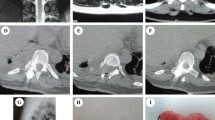Abstract
Study design
Retrospective case series.
Objective
To evaluate our treatment strategy for cervical dumbbell neurinoma.
Summary of background data
In treating cervical dumbbell neurinoma, possible difficulties include reoperation due to recurrent tumor, denervation due to nerve root resection, and postoperative spinal deformity due to extensive bony removal.
Methods
We reviewed 75 cases of cervical dumbbell neurinoma that were treated surgically between 1985 and 2006. Postoperative neurological deficits, effects of surgical margins on tumor recurrence, and surgical complications were investigated retrospectively.
Results
Sensory and motor deficits due to resection of specific nerve roots appeared temporarily in 33 and 23 % of all cases, and persisted in 8 and 8 % at final evaluation, respectively. Total, subtotal, and partial resection was performed in 57, 13, and 5 cases, respectively. The total resection rate was low in the tumors that had large extraforaminal components. Of the subtotally resected 13 cases, only two cases of high tumor-growth rate required re-operation or showed tumor growth. Among the five partially resected cases, re-operation was necessary in two cases 13 and 15 years later because of aggravated neurological symptoms due to tumor growth. Two patients who underwent C2 laminectomy developed kyphosis, and three patients who underwent facet joint resection and curettage of vertebral body lesions developed scoliosis.
Conclusion
Total resection should be attempted for cervical dumbbell tumors. In cases where total resection was potentially of high risk, however, subtotal resection (within the capsule) was found to be a practical choice yielding favorable long-term outcome when the tumor growth rate (MIB-1 index) was low.


Similar content being viewed by others
References
Conti P, Pansini G, Mouchaty H, Capuano C, Conti R. Spinal neurinomas: retrospective analysis and long-term outcome of 179 consecutively operated cases and review of the literature. Surg Neurol. 2004;61:34–43. (discussion 4).
Asazuma T, Toyama Y, Maruiwa H, Fujimura Y, Hirabayashi K. Surgical strategy for cervical dumbbell tumors based on a three-dimensional classification. Spine (Phila Pa 1976). 2004;29:E10–4.
Jiang L, Lv Y, Liu XG, Ma QJ, Wei F, Dang GT, Liu ZJ. Results of surgical treatment of cervical dumbbell tumors: surgical approach and development of an anatomic classification system. Spine (Phila Pa 1976). 2009;34:1307–14.
Klekamp J, Samii M. Surgery of spinal nerve sheath tumors with special reference to neurofibromatosis. Neurosurgery. 1998;42:279–89. (discussion 89–90).
Lot G, George B. Cervical neuromas with extradural components: surgical management in a series of 57 patients. Neurosurgery. 1997;41:813–20. (discussion 20–2).
McCormick PC. Surgical management of dumbbell tumors of the cervical spine. Neurosurgery. 1996;38:294–300.
Celli P. Treatment of relevant nerve roots involved in nerve sheath tumors: removal or preservation? Neurosurgery. 2002;51:684–92. (discussion 92).
Kim P, Ebersold MJ, Onofrio BM, Quast LM. Surgery of spinal nerve schwannoma. Risk of neurological deficit after resection of involved root. J Neurosurg. 1989;71:810–4.
Schultheiss R, Gullotta G. Resection of relevant nerve roots in surgery of spinal neurinomas without persisting neurological deficit. Acta Neurochir (Wien). 1993;122:91–6.
Fassett DR, Clark R, Brockmeyer DL, Schmidt MH. Cervical spine deformity associated with resection of spinal cord tumors. Neurosurg Focus. 2006;20:E2.
Sciubba DM, Chaichana KL, Woodworth GF, McGirt MJ, Gokaslan ZL, Jallo GI. Factors associated with cervical instability requiring fusion after cervical laminectomy for intradural tumor resection. J Neurosurg Spine. 2008;8:413–9.
Asazuma T, Nakamura M, Matsumoto M, Chiba K, Toyama Y. Postoperative changes of spinal curvature and range of motion in adult patients with cervical spinal cord tumors: analysis of 51 cases and review of the literature. J Spinal Disord Tech. 2004;17:178–82.
Watanabe M, Sakai D, Yamamoto Y, Iwashina T, Sato M, Mochida J. Upper cervical spinal cord tumors: review of 13 cases. J Orthop Sci. 2009;14:175–81.
Zhao B, Xu J. Extensive posterolateral exposure and total removal of the giant extraforaminal dumbbell tumors of cervical spine: surgical technique in a series of 16 patients. Spine J. 2009;9:822–9.
Conflict of interest
The authors declare no conflict of interest.
Author information
Authors and Affiliations
Corresponding author
About this article
Cite this article
Nakamura, M., Iwanami, A., Tsuji, O. et al. Long-term surgical outcomes of cervical dumbbell neurinomas. J Orthop Sci 18, 8–13 (2013). https://doi.org/10.1007/s00776-012-0300-2
Received:
Accepted:
Published:
Issue Date:
DOI: https://doi.org/10.1007/s00776-012-0300-2




